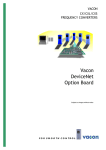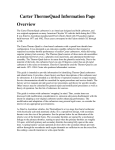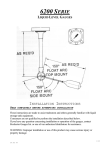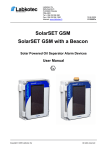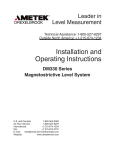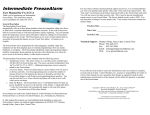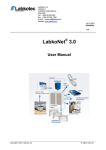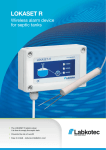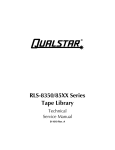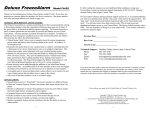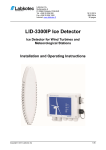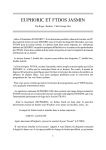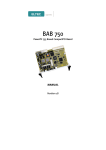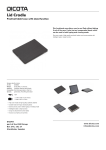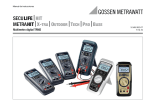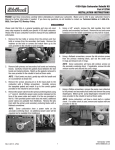Download LabkoMax ® MPS-4 Level Interface 7100 series
Transcript
Labkotec Oy Myllyhaantie 6 FI-33960 PIRKKALA Tel. +358 29 006 260 Fax +358 29 006 1260 E-mail: [email protected] Internet: www.labkotec.fi 01.04.2010 D30579De LabkoMax® MPS-4 Level Interface 7100 series LabkoMax and LabkoFlex probes INSTALLATION AND OPERATING INSTRUCTIONS Copyright © 2010 Labkotec Oy We reserve rights for changes without notice LabkoMax® MPS-4 Level Interface 7100 series LabkoMax ja LabkoFlex probes Installation and operating instructions D30579De CONTENTS 1. GENERAL ________________________________________________________________________ 3 1.1 LABKOMAX LEVEL MEASUREMENT SYSTEM ____________________________________ 3 1.2 TECHNICAL SPECIFICATIONS ___________________________________________________ 4 2. INSTALLATION __________________________________________________________________ 5 2.1 INSTALLATION OF THE 7100 SERIES LabkoMax PROBE ____________________________ 5 2.3 CABLING _______________________________________________________________________ 8 3. MPS-4 CONFIGURATION AND SETTINGS _________________________________________ 11 3.1 COMMUNICATION SETTINGS ___________________________________________________ 11 3.1.1 BAUDRATE SETTINGS _______________________________________________________________ 11 3.1.2 RS-232/RS-485 SETTINGS _____________________________________________________________ 12 3.3 SETUP COMMANDS ____________________________________________________________ 14 3.3.1 SETTING THE WIRE SPEED ___________________________________________________________ 3.3.2 PROBE TYPE SETTING _______________________________________________________________ 3.3.3 SETTING THE LEVEL MEASUREMENT _________________________________________________ 3.3.4 SETTING THE MINIMUM PRODUCT LEVEL _____________________________________________ 3.3.5 NUMBER OF FLOATS SETTING________________________________________________________ 3.3.6 SETTING THE MINIMUM FLOAT DISTANCE ____________________________________________ 3.3.7 SETTING THE WATER FLOAT OFFSET _________________________________________________ 3.3.8 SETTING THE MINIMUM WATER LEVEL _______________________________________________ 3.3.9 SETTING THE FLOAT TYPE ___________________________________________________________ 3.3.10 SELECTING THE RESULT MODE _____________________________________________________ 3.3.11 SETTING THE VOLUME OF THE TANK ________________________________________________ 3.3.12 SETTING THE DIAMETER OF THE TANK ______________________________________________ 3.3.13 ERASING THE CONVERSION TABLE __________________________________________________ 3.3.14 FILLING IN THE CONVERSION TABLE ________________________________________________ 3.3.15 READING THE CONVERSION TABLE _________________________________________________ 3.3.16 SETTING THE NUMBER OF POINTS IN THE CONVERSION TABLE ________________________ 3.3.17 CORRECTING CONVERSION TABLE POINT ____________________________________________ 3.3.18 SETTING THE LOW LEVEL ALARM ___________________________________________________ 3.3.19 SETTING THE HIGH LEVEL ALARM __________________________________________________ 3.3.20 SETTING THE CONDENSEDWATER ALARM ___________________________________________ 3.3.21 READING PARAMETER VALUES _____________________________________________________ 15 15 16 16 16 17 17 18 18 19 19 19 20 20 20 21 22 22 22 22 23 4. INQUIRY COMMANDS ___________________________________________________________ 24 4.1 LEVEL/VOLUME INQUIRY _____________________________________________________________ 4.2 LEVEL INQUIRY ______________________________________________________________________ 4.3 TEMPERATURE INQUIRY ______________________________________________________________ 4.3.1 TEMPERATURE INQUIRY FOR FIVE TEMPERATURES ___________________________________ 4.4 CONDENSED WATER LEVEL INQUIRY __________________________________________________ 4.5 WATER LEVEL/VOLUME INQUIRY ______________________________________________________ 4.6 ALL VALUES INQUIRY ________________________________________________________________ 24 24 24 25 25 25 25 5. ADDITIONAL INQUIRY COMMANDS _____________________________________________ 26 5.1 PROBE STATUS INQUIRY ______________________________________________________________ 26 6. MAINTENANCE _________________________________________________________________ 27 6.1 HARDWARE FAULTS __________________________________________________________________ 27 6.2 MEASURING FAULTS__________________________________________________________________ 27 Copyright © 2010 Labkotec Oy We reserve rights for changes without notice Page 2 LabkoMax® MPS-4 Level Interface 7100 series LabkoMax ja LabkoFlex probes Installation and operating instructions D30579De 1. GENERAL 1.1 LABKOMAX LEVEL MEASUREMENT SYSTEM The LabkoMax level measurement system contains the following devices and software: 7100 series magnetostrictive LabkoMax and LabkoFlex level probes MPS-4 level interface (power supplies and Ex-barriers) MD-1 Current loop / RS-232 converter ME-3 Display unit LabkoMonitor 8 Fuel tank monitoring software Fig. 1. LabkoMax measurement system alternatives. Additional information can be found in following documents: LabkoFLex Installation and handling procedure (Doc. No. D30660) MD-1 Current loop / RS-232 converter, installation and operating instructions (Doc. No. D30165) ME-3 Installation and user manual (Doc. No. D30013) Labcom 800 Operating and Installation Instruction (Doc. No. D04063) LabkoMonitor 8 Installation and Operating Instructions (Doc. No. D30643) LabkoMax Configurator Installation program Installation and Operating Instructions (Doc No D30640) LabkoNet www.labkonet.com Copyright © 2010 Labkotec Oy We reserve rights for changes without notice Page 3 LabkoMax® MPS-4 Level Interface 7100 series LabkoMax ja LabkoFlex probes Installation and operating instructions D30579De 1.2 TECHNICAL SPECIFICATIONS LabkoMax MPS-4 Level Interface Number of probes: Output values: Output format: Level resolution: Level linearity: Volume resolution: Water level resolution: Temperature resolution: Temperature accuracy: Configuration: Power supply: Operation temperature range: Enclosure protection class: Dimensions: Ex-classification: 1…4 pcs 7100 series LabkoMax or LabkoFlex probes Procuct level, product volume, water level, water volume and temperature Digital serial communication in 20 mA current loop using LABKO ILS protocol, 300...4800 baud. Optional RS-485 MODBUS 0,1 mm ±0,01% FS tai ±0,25 mm (whichever is greater) 0,1 l 0,1 mm 0,01°C ±0,3°C (-20 … +65°C) With code switches and through the serial port with Windows based LabkoMax Configurator Installation program 230 (±10%) VAC, 50/60 Hz, 4,5VA -20 … +50°C IP65 250 x 175 x 75 mm II (1) G [Ex ia] II B VTT 03 ATEX 079X Special conditions: Ta = -25°C … +50°C Io = 117 mA Po = 883 mW Output values IIB: Uo = 30 V Co = 320 nF Lo = 5 mH Lo/Ro = 159µH/Ω Linear output. See chapter 2.3 To probes: shielded twisted pair, max. length 600 m. Cabling requirements: To host: instrument cable 1x(2+1)x0,5 mm2, max. length 400 m. Isolated serial communication converter Options: RS-232/485, 300…19200 Bd EMC: Immunity EN 50082-1 EN 50082-2 Emission EN 50081-1 AAA(006) B CCC DD EE F Year of manufacture: See serial number from the type where EE = year of manufacture (e.g. 10 = 2010) plate Copyright © 2010 Labkotec Oy We reserve rights for changes without notice Page 4 LabkoMax® MPS-4 Level Interface 7100 series LabkoMax ja LabkoFlex probes Installation and operating instructions D30579De 2. INSTALLATION This manual describes the installation of the 7100 series LabkoMax probe and the MPS-4 level interface unit. LabkoFlex probe is provided in it’s own installation manual (see page 3). Installation instructions for the ME-3 display unit MD-1 current loop / RS-232 converter, and LabkoMonitor 8 monitoring software are provided in their own manuals (see page 3). 2.1 INSTALLATION OF THE 7100 SERIES LabkoMax PROBE The probe must be installed to 2”, 3” or 4” riser pipe. For installation, there must be a welded sleeve fitted with R2”, R3” or R4” internal thread on the top of the tank. Recommended riser pipe length is 550 mm. Fig. 2. Riser pipe Example of determining riser pipe length Height measured from bottom of the tank to manhole cover in mm Total length of the probe in mm Minimum riser pipe length in mm. 1700 2080 (82”) 480 2100 2490 (98”) 490 2600 3000 (118”) 500 Copyright © 2010 Labkotec Oy We reserve rights for changes without notice Page 5 LabkoMax® MPS-4 Level Interface 7100 series LabkoMax ja LabkoFlex probes Installation and operating instructions D30579De In the above table it is taken into account that here must be at least 100 mm between top of probe to riser pipe’s top flange. Total length of the probe in the above table is the length that must be used when ordering the probe. Values indicated in the table are standard lengths available in the stock. Before installation, write down the wire speed of the measurement signal of each probe. The wire speed is located in the label at the probe head, for instance WS: 9.064 uSEC/INCH. Cable gland Fig. 3. Installation of the probe. The installation is carried out as follows: - install the riser pipe to the tank. - install probe spacers, probe grounding ring, floats, protecting sleeve, probe foot fastening adapter and probe foot to the probe. Product float must be above the water float. With 2” steel floats product float and water float are identical, but there is metal collar above the water float to add weight, and second collar under the water float to prevent lowering the water float under the probe’s measuring range. 3” and 4” polyurethane water floats have ballast plate on bottom. Insure that you are using a proper water float: for gasoline there is stamped 85 on the ballast plate and for diesel there is 95. - screw the connection cable to the probe - slide the floats to the bottom of the probe shaft. Note: The product float must be above water float. Insert the probe in the riser pipe and lower it to the bottom of the tank. Copyright © 2010 Labkotec Oy We reserve rights for changes without notice Page 6 LabkoMax® MPS-4 Level Interface 7100 series LabkoMax ja LabkoFlex probes Installation and operating instructions D30579De - insert the cable through the gland on the riser pipe cap, attach the grounding wire to the grounding ring of the probe and to the riser pipe cap - attach the cap and the cap’s grounding wire - tighten the cable gland and connect the cable to the junction box. Fig. 4. Connecting probe to the junction box. Junction box is normally connected to the system’s equipotential ground via mounting plate and riser pipe’s cover flange, but if this not the case, then junction box must be connected to the equipotential ground with at least 4 mm2 wire. When installing the probe in an underground tank the following facts shall be taken into account: - the space above the entry must be free to allow the installation and service of the probe (it must be possible to lift up the probe from the tank) - the installation shaft shall be sufficiently large (diameter ≥1 m) to allow the installation and connection of the probe Copyright © 2010 Labkotec Oy We reserve rights for changes without notice Page 7 LabkoMax® MPS-4 Level Interface 7100 series LabkoMax ja LabkoFlex probes Installation and operating instructions D30579De 2.2 INSTALLATION OF THE MPS-4 LEVEL INTERFACE UNIT The MPS-4 must always be installed in the non-hazardous area. The protection class of the unit’s enclosure (dust tight and jet proof to IP 65) must be taken into account. The MPS-4 can be mounted permanently on wall or in a device cabinet in the field, for example. The unit is fastened with four screws through the holes in the corners of the housing. Mounting dimensions 235 x 160 mm. Fig. 5. MPS-4 mounting dimensions. 2.3 CABLING NOTE! MPS-4 control unit must not be installed in explosion-hazardous zone. However, it is allowed to install the 7100-probe in explosion-hazardous zone (0/1/2). When doing so, the following standards need to be followed; EN 50039 Electrical apparatus for potentially explosive atmospheres – Intrinsically safe electrical systems “I”, EN 60079-14 Electrical apparatus for explosive gas atmospheres. Part 14: Electrical installation in hazardous areas. The table below shows the maximum combined capacitance and inductance values for explosion group IIB for the MPS-4 control unit. For group IIA, values for IIb can be applied. IIB Co Lo 320 nF 0,15 mH 240 nF 1 mH 210 nF 2 mH 180 nF 5 mH Copyright © 2010 Labkotec Oy We reserve rights for changes without notice Page 8 LabkoMax® MPS-4 Level Interface 7100 series LabkoMax ja LabkoFlex probes Installation and operating instructions D30579De A shielded 2-conductor cable must be used between the MPS-4 unit and the probe. When cable conductors have at least 0.5 mm2 cross section, maximum cable length is 600 meters if capacitance and inductance values are within allowed limits. To equipotential ground Fig. 6. Connection between the MPS-4 and the 7100 probe. The cable between the 7100 probe and the MPS-4 level interface unit is connected as shown in the figure 6. The cable shield is connected to terminal 3 in the junction box. At the MPS-4 end of the cable the shield is not connected and it must be isolated (for example by insulating tape). The riser pipe and all other metal parts must be connected to the system’s equipotential ground by conductor having at least 4 mm2 cross section. The mains supply to the MPS-4 (230 Vac) is connected to the terminals marked L1, N and PE. MPS-4 units mains supply lines must be equipped with decoupling switch (250Vac/1A) to ease use and maintenance. This switch must be located near the MPS-4 unit and must be labeled as unit’s decoupling switch. All connections should be appropriately made and checked before connecting mains supply. For the current loop cabling between the MPS-4 level interface units and the host unit (such as ME-3), it is recommended to use a 2-conductor shielded cable with a minimum Copyright © 2010 Labkotec Oy We reserve rights for changes without notice Page 9 LabkoMax® MPS-4 Level Interface 7100 series LabkoMax ja LabkoFlex probes Installation and operating instructions D30579De conductor area of 0.5 mm2. When using this type of cable, the total current loop length can be up to 400 m. The current loop from the MPS-4 to the host unit is connected to CL+ and CL- terminals on the LINE connection. The cable shield is connected to the terminal 1. This potential free terminal is designed to be used as an extension terminal for the shields of the cables of series connected MPS-4 units. When using several MPS-4 units, the current loop connections (LINE) of these units are connected in series. Fig. 7. Connecting several MPS-4 units in series. The digital 20 mA current loop of the MPS-4 can be converted into an RS-232 serial interface using the RS-232/485 adapter card for MPS-4. The RS-232 interface is needed when using the LabkoMonitor 8 software or connecting the MPS-4 to a modem or POS. Fig. 8. MPS-4 RS-232 interface using optional RS-232/485 adapter card. When connecting multiple MPS-4 units to a host controller with RS-232 communication, the units are connected in series with current loop and converted to RS-232 using MD-1 converter. See the MD-1 manual for additional information. Copyright © 2010 Labkotec Oy We reserve rights for changes without notice Page 10 LabkoMax® MPS-4 Level Interface 7100 series LabkoMax ja LabkoFlex probes Installation and operating instructions D30579De 3. MPS-4 CONFIGURATION AND SETTINGS The configuration of the MPS-4 is done with three rotary switches and with ASCII commands using the serial communication port of the MPS-4. The rotary switches are located in upper left corner of the circuit card. The settings from these switches are detected only on powering up the MPS-4, so if the settings are changed the power supply for the MPS-4 must be reconnected or the RESET button must be pressed. 1 2 3 4 Fig. 9. MPS-4 configuration switches at the upper left corner of the circuit board. The six switches (S4...S9) behind the current loop terminals (CL+, CL-) must all be in the right hand position. Measurement settings are made using computer (PC) with RS-232 communication port. If MPS-4 unit is not equipped with RS-232/485 adapter card, then digital current loop/RS232 converter MD-1 (or equivalent) must be used. If MPS-4 unit is connected to ME-3 display unit, then settings can be made through the RS-232 port of the ME-3. Settings can be made with LabkoMax Configurator program (Windows) or Windows Hyperterminal. 3.1 COMMUNICATION SETTINGS 3.1.1 BAUDRATE SETTINGS The communication speed of the MPS-4 serial port is selected with switch S3. The settings are: switch position communication speed 0 300 bd (default, used with ME-3) 1 1200 bd 2 2400 bd (default with Labcom 800) 3 4800 bd 4 9600 bd (RS232/485 only) 5 19200 bd (RS232/485 only) The other communication parameters are: 8 data bits, 1 stop bit, no parity. Copyright © 2010 Labkotec Oy We reserve rights for changes without notice Page 11 LabkoMax® MPS-4 Level Interface 7100 series LabkoMax ja LabkoFlex probes Installation and operating instructions D30579De 3.1.2 RS-232/RS-485 SETTINGS Fig. 10. LabkoMax MPS-4 adapter, switch positions If there are multiple MPS-4 units connected to the same RS-485 line, then termination resistor must be activated only in the unit at the end of the line. Copyright © 2010 Labkotec Oy We reserve rights for changes without notice Page 12 LabkoMax® MPS-4 Level Interface 7100 series LabkoMax ja LabkoFlex probes Installation and operating instructions D30579De 3.2 SETTING THE PROBE IDENTIFICATION NUMBERS In this system each probe has it’s own identification number. The number range is from 01 to 99. There are four connectors for probes (PROBE 1,2,3,4) in the MPS-4. The number of the first probe (PROBE 1) is set by two rotary switches. The rest three probes are automatically numbered in ascending order (number of the previous probe plus one). For instance, if the number of the first probe is set to 01, then PROBE 2 is 02, PROBE 3 is 03 and PROBE 4 is 04. Fig. 11. Rotary switches S1, S2 and S3. If there is no probe connected to a probe connector, that number is still reserved. PROBE 1 terminals are 11 and 12 (left hand side on the circuit board), PROBE 2 terminals 21 and 22, PROBE 3 terminals 31 and 32, PROBE 4 terminals 41 and 42. If two MPS-4 units are used then identification numbers must be set so that number ranges do not overlap. Example: If first unit’s identification number rotary switches are set to 01, then second unit’s rotary switches must be set to 05 or higher. Copyright © 2010 Labkotec Oy We reserve rights for changes without notice Page 13 LabkoMax® MPS-4 Level Interface 7100 series LabkoMax ja LabkoFlex probes Installation and operating instructions D30579De 3.3 SETUP COMMANDS The most important setup commands of the MPS-4 interface are explained below. Commands can be given with Windows based LabkoMax Configurator software or by means of PC’s communication program. The settings for the communication between PC and MPS-4 are: baud rate (the same as set to MPS-4), 8 data bits, 1 stop bit, no parity. Using the setup commands requires that a serial RS-232 interface is available for the MPS-4. Such an interface is incorporated in the RS232/485 adapter for MPS-4, MD-1 and ME-3 units, for example. At the startup there must be at least the following two settings made correctly: - Setting the wire speed of the measurement signal (3.3.1). - Probe type setting (3.3.2). - Setting the level measurement (3.3.3). Notice: Setting the wire speed must be carried out before any other settings. Because the product float cannot mechanically descent to position corresponding zero level measured from the bottom of the tank, it is useful to specify minimum level value under which level is always interpreted to be zero. This minimum level value is set by: - Setting the minimum product level (3.3.4). Number of floats setting: - Number of floats setting (3.3.5) If the product float and the water float touch each other and do not float freely, level measurement is not accurate. Therefore minimum float distance is specified by: - Setting the minimum float distance (3.3.6). Reading of probe status (5.1) can be used to ensure the floats are not closer to each other than specified by minimum float distance. To be accurate, water bottom measurement requires: -Setting the water float offset (3.3.7). As with the product float, the water float can not descent to zero level measured from the bottom of the tank either, and following setting is needed: - Setting the minimum water level (3.3.8). Some settings are dependant of the float type and therefore following setting can be used to check these settings: - Setting the float type (3.3.9) Method of calculation of the volume of the product is specified by: - Setting the result mode (3.3.10). If result mode is set to zero, then no additional settings are needed to calculate volume because level/volume inquiry returns level of the product. If result mode is set to one, then following settings must carried out: - Setting the volume of the tank (3.3.11). - Setting the diameter of the tank (3.3.12). Copyright © 2010 Labkotec Oy We reserve rights for changes without notice Page 14 LabkoMax® MPS-4 Level Interface 7100 series LabkoMax ja LabkoFlex probes Installation and operating instructions D30579De If result mode is two, the user specified conversion table is used. Following commands are used to set the conversion table: - Erasing the conversion table (3.3.13). - Filling in the conversion table (3.3.14). Conversion table can be displayed by read conversion table command (3.3.15). To make corrections to already filled conversion table, following commands are useful: - Setting the number of points in the conversion table (3.3.16). - Correct conversion table point (3.3.17). Level and volume inquiries contain status of the limits which are set by following commands: - Setting the low level alarm (3.3.18). - Setting the high level alarm (3.3.19). - Setting the condensed water alarm (3.3.20). Setting can be displayed by read parameters command (3.3.21). All commands are made up of two characters, a two-digit probe number and a parameter, if any. The command is ended by pressing the ENTER key (RETURN, carriage return). The probe number is used to address the command to the desired probe. In the command instructions the following markings are used: n1n2 probe number (01...99) <CR> carriage return (RETURN, ENTER) The MPS-4 responds to all setup commands executed and acknowledged using two characters: #<CR>. 3.3.1 SETTING THE WIRE SPEED $Yn1n2x1...x4<CR> Each probe has its own speed of wire value. The speed of wire is marked on the label on probe head. This value is given as an integer in the place of x1...x4 for the probe in question, for instance the wire speed 9.034 µs/inch for the probe 01 is given as $Y019034<CR>. This value is shown as WireSpeed in the output of the RP command. 3.3.2 PROBE TYPE SETTING PTnnt, where nn is probe number (01,...,99) and t (1,...,6) is probe type. Types 1,4 0"< probe length <=216" Types 2,5 216"< probe length <=288" Types 3,6 288"< probe length Probe types 1, 2 and 3 have 5 thermistor probes (R5 designation in part number). Probe types 4, 5 and 6 have 1 thermistor probes (R1 designation in part number). Default value for probe type is 4. Copyright © 2010 Labkotec Oy We reserve rights for changes without notice Page 15 LabkoMax® MPS-4 Level Interface 7100 series LabkoMax ja LabkoFlex probes Installation and operating instructions D30579De 3.3.3 SETTING THE LEVEL MEASUREMENT $Zn1n2m1...m4<CR> This command is used to calibrate the level readout to correspond to the actual level measured by a gauge stick from the bottom of the tank. The measured value is given as parameter m1...m4 in millimetres. The level of the product must be at least 200 mm to execute the level setting command. Example. If the level is measured to be 1557 mm in the tank with probe’s identification number 01, then following command is given: $Z011557<CR> 3.3.4 SETTING THE MINIMUM PRODUCT LEVEL LMn1n2m1...m4<CR> This parameter is given as tenths of millimetre and specifies level under which level is displayed as zero. Because the product float cannot descent to position corresponding zero level measured from the bottom of the tank, there is minimum level under which level can not be measured. Because the product float is above the water float minimum level must be at least height of the water float added by sinking depth of the product float. If 2” steel floats are used, then collars above and under the water float must be taken into account. In the table collars are assumed to be 10 mm high. Following table contains minimum level measured from the bottom of the tank for different floats. Values in the table are based on measurement which were made with the floats and various liquids. Because actual conditions can differ from measurement conditions, more accurate values can be determined when measurements are made in real operating environment. Float type Minimum level in mm from the bottom of the tank that can be measured Parameter value with the setting command 2” steel 149 1490 2” nitrophyl 176 1760 3” polyureth. 82 820 4” polyureth. 79 790 Example. Probe with identification number 01 is equipped with 3” floats. Minimum level is set to 82.0 mm using following command: LM01820<CR> This value is shown as MinLevel in the output of the RP command. 3.3.5 NUMBER OF FLOATS SETTING FCnnk, where nn is probe number (01,...,99) and k (1,2) is number of floats. Default value is 2. Copyright © 2010 Labkotec Oy We reserve rights for changes without notice Page 16 LabkoMax® MPS-4 Level Interface 7100 series LabkoMax ja LabkoFlex probes Installation and operating instructions D30579De 3.3.6 SETTING THE MINIMUM FLOAT DISTANCE MDn1n2m1...m4<CR> Minimum float distance which is given in tenths of millimetre specifies how close to each other floats can be without causing errors to measurement. Because the probe measures position of the magnets attached to the floats, this parameter means minimum distance of the magnets. With 2” steel floats weighting collar above the water float must be taken into account and in the following table it is assumed to be 10 mm high. Float type Minimum distance in mm Parameter value with the setting command 2 “ steel 86 860 2” nitrophyl 78 780 3” polyureth. 65 650 4” polyureth. 71 710 Example. Probe with identification number 01 is equipped with 3” floats. Minimum distance is set to 65.0 mm using following command: MD01650<CR> This value is shown as MinFloatDist in the output of the RP command. 3.3.7 SETTING THE WATER FLOAT OFFSET FDn1n2m1...m4<CR> The water float offset, which given in tenths of millimetre, is used to correct the difference in floating depths of the product float and the water float. Given value is added to the measured water level. A positive value must be given if measured water level is lower than the actual water level. Float Difference in floating depths in mm Parameter value with the setting command gasoline diesel gasoline diesel 2 “ steel -3 -13 -30 -130 2” nitrophyl -70 -62 -700 -620 3” polyureth. 3 11 30 110 4” polyureth. -6 3 -60 30 Notice: Values in the above table are only approximate. More accurate values can be acquired by measuring floating depths in actual situation. Example. Probe 01 is equipped with 3” floats. Water float offset is set to 11.0 mm by following command: FD01110<CR> This value is shown as WfOffset in the output of the RP command. Copyright © 2010 Labkotec Oy We reserve rights for changes without notice Page 17 LabkoMax® MPS-4 Level Interface 7100 series LabkoMax ja LabkoFlex probes Installation and operating instructions D30579De 3.3.8 SETTING THE MINIMUM WATER LEVEL WMn1n2m1...m4<CR> This parameter which given in tenths of millimetre is needed because, as with the product float, the water float can not descent zero level measured from the bottom of the tank. Water levels below this value are displayed as zero. NOTE! The values mentioned in the table below are only estimates. The actual setting should be done as follows. 1. Set the value of minimum water level first to a value of 0 mm. 2. Check the value of condensed water level with command $G (chapter 4.4). 3. Set the minimum water value to a value which is 2 mm higher than just checked. 4. Check the condensed water level again. It should now be 0 mm. Float Minimum water level in mm Parameter value with the setting command gasoline diesel gasoline diesel 2 “ steel 74 64 740 640 2” nitrophyl 30 38 300 380 3” polyureth. 18 26 180 260 4” polyureth. 6 15 60 150 Example. Probe 01 is equipped with 3” floats and measures level gasoline level. Minimum water level is set to 18.0 mm by following command: WMn1n2m1...m4<CR> This value is shown as MinWater in the output of the RP command. 3.3.9 SETTING THE FLOAT TYPE FTn1n2x<CR> This command is used to set the type of the floats for each probe. This setting is given for the product float/water float pair. For specific size, product floats are the same for gasoline and diesel, but water floats have different weights. The values of x for each float type are listed below: x type of the float 1 2” stainless for gasoline 2 2” stainless for diesel 3 3” polyurethane for gasoline 4 3” polyurethane for diesel 5 4” polyurethane for gasoline 6 4” polyurethane for diesel Copyright © 2010 Labkotec Oy We reserve rights for changes without notice Page 18 LabkoMax® MPS-4 Level Interface 7100 series LabkoMax ja LabkoFlex probes Installation and operating instructions D30579De 7 2” nitrophyl for gasoline 8 2” nitrophyl for diesel Example. Probe 01 measures gasoline level and is equipped with 3” polyurethane floats. Float type is configured by: FT013<CR> This value is shown as FloatType in the output of the RP command. 3.3.10 SELECTING THE RESULT MODE $Dn1n2x<CR> By the $V and $A inquiry commands the level measured can be sent in three different modes depending on the parameter x stored in the memory as follows: x=0 x=1 x=2 result in millimetres result in litres, calculated using the built-in level-to-volume table for a horizontal, cylindrical tank result according to the values stored in the conversion table Example. Probe 01 is configured to calculate volume using the built-in level-to-volume table for a horizontal, cylindrical tank by following command: $D011<CR> This value is shown as ResultMode in the output of the RP command. 3.3.11 SETTING THE VOLUME OF THE TANK (This setting is needed only when result mode is set to 1.) $Qn1n2l1...l6<CR> When using the built-in level-to-volume table (result mode = 1), this command is used to save the volume of a horizontal, cylindrical tank in litres (l1...l6). Example: Probe 01 installed in tank which has 22000 l configured by: nominal volume. This is $Q0122000<CR> This value is shown as NomVolume in the output of the RP command. 3.3.12 SETTING THE DIAMETER OF THE TANK (This setting is needed only when result mode is set to 1.) $Rn1n2m1...m4<CR> When using the built-in level-to-volume table (result mode = 1), this command is used to save the diameter of a horizontal, cylindrical tank in millimetres m1...m4. Example. Probe 01 is in a tank with 1850 mm diameter. This is set by: $R011850<CR> Copyright © 2010 Labkotec Oy We reserve rights for changes without notice Page 19 LabkoMax® MPS-4 Level Interface 7100 series LabkoMax ja LabkoFlex probes Installation and operating instructions D30579De This value is shown as Diameter in the output of the RP command. 3.3.13 ERASING THE CONVERSION TABLE (This setting is used when result mode is set to 2.) $En1n2<CR> This command as all commands affecting the user given conversion table are used only if result mode 2 is selected. Before starting to store new pairs of values in the table, the table pointer must be set to its initial value using this command. (This is thus done only once before programming all 2...32 points in the table). Example. Erase conversion table used by probe 01: $E01<CR> 3.3.14 FILLING IN THE CONVERSION TABLE (This setting is used when result mode is set to 2.) $Fn1n2m1...m4/l1...l6<CR> Conversions of units and level-to-volume can be made by setting in the conversion table the desired m1...m4 readings in millimetres and the corresponding l1...l6 values in the desired units. The result to be sent using the $V inquiry command is calculated linearly between these set points, when the corresponding result mode has been selected. Filling in the table must be started from the lowest level. It is recommended to set 0/0 as the first point. The m1...m4 and l1...l6 values shall always be higher than those of the previous point. At least two points must be stored; the max. number of these freely selectable points is 32. When storing the points, the current level has no significance. The difference between successive volume readings must not exceed 65000. If the level exceeds the highest table point the volume value is extrapolated using the two highest table point. Example: Probe 01 volume is calculated with conversion table where 450 mm corresponds to 2000 l, 900 mm to 6000 l, 1350 mm to 13000 l and 1700 mm level corresponds 19500 l volume. This table is configured by following commands: $F010/0<CR> $F01450/2000<CR> $F01900/6000<CR> $F011350/13000<CR> $F011700/19500<CR> 3.3.15 READING THE CONVERSION TABLE RTn1n2<CR> This command displays the points stored in the conversion table (level/corresponding reading). Example of displayed data (5 points stored in the table): Copyright © 2010 Labkotec Oy We reserve rights for changes without notice Page 20 LabkoMax® MPS-4 Level Interface 7100 series LabkoMax ja LabkoFlex probes Installation and operating instructions D30579De 0 0<CR> 450 2000<CR> 900 6000<CR> 1350 13000<CR> 1700 19500#<CR> 3.3.16 SETTING THE NUMBER OF POINTS IN THE CONVERSION TABLE SXn1n2x<CR> This command sets the number of the points (0…32) in the conversion table and it is used only in special cases when the configured table needs editing. When the table points are filled, the point count number is automatically incremented. With this command the number of points which are taken into account can be reduced. Example. In the previous example of filling the conversion table, five points were given. Point count can be set to 3 with following command: SX013<CR> And points 4 and 5 can be given again with new values: $F011350/14000<CR> $F011800/19500<CR> Points 4 and 5 can be corrected also by using following command. Copyright © 2010 Labkotec Oy We reserve rights for changes without notice Page 21 LabkoMax® MPS-4 Level Interface 7100 series LabkoMax ja LabkoFlex probes Installation and operating instructions D30579De 3.3.17 CORRECTING CONVERSION TABLE POINT CTn1n2p1p2m1...m4/l1...l6<CR> This command is used to correct values in the conversion table. Number of the point to correct p1p2 (01…32). Example. Correcting point 02 in probe 01 conversion table: CT0102450/2100<CR> 3.3.18 SETTING THE LOW LEVEL ALARM $Ln1n2m1...m4<CR> This command is used to set the low level alarm to the desired level m1...m4 in millimetres. This setting is necessary only if required by the central unit used. Example. Alarm level for probe 01 is set to 300 mm by following command: $L01300<CR> This value is shown as LlvlAlarm in the output of the RP command. 3.3.19 SETTING THE HIGH LEVEL ALARM $Hn1n2m1...m4<CR> This command is used to set the high level alarm to the desired level m1...m4 in millimetres. This setting is necessary only if required by the central unit used. Example. High level alarm for probe 01 is set 1820 mm: $H011820<CR> This value is shown as HlvlAlarm in the output of the RP command. 3.3.20 SETTING THE CONDENSEDWATER ALARM $Wn1n2m1...m4<CR> This command is used to set the water bottom alarm to the desired level m1...m4 in millimetres. This setting is necessary only if required by the central unit used. Example: Water bottom alarm for probe 01 is set to 30 mm: $W0130<CR> This value is shown as WaterAlarm in the output of the RP command. Copyright © 2010 Labkotec Oy We reserve rights for changes without notice Page 22 LabkoMax® MPS-4 Level Interface 7100 series LabkoMax ja LabkoFlex probes Installation and operating instructions D30579De 3.3.21 READING PARAMETER VALUES RPn1n2<CR> This command displays the names of the parameters and their values. Example. Response to RP command WireSpeed = 9.034 Offset = -16.49 WfOffset = 11.0 MinLevel = 82.0 MinWater = 18.0 MinFloatDist = 65.0 FloatType = 3 LevelTC = 30 WaterTC = 30 TempTC = 60 ResultMode = 2 Diameter = 1850 NomVolume = 22000 LlvlAlarm = 300 HlvlAlarm = 1820 WaterAlarm = 30 TablePoints = 5 # Wire speed (3.3.1) of the probe’s measuring signal. This value is calculated when level measurement is set (3.3.3). Water float offset = 11.0 mm (3.3.7). Minimum level = 82.0 mm (3.3.4). Minimum water level = 18.0 mm (3.3.8). Minimum float distance = 65.0 mm (3.3.6). Float type (3.3.9). Filter coefficient for level measurement (factory setting). Filter coefficient for water level measurement (factory setting). Filter coefficient for temperature measurement (factory setting). Result mode (3.3.10). Tank diameter = 1850 mm (3.3.12). Tank volume = 22000 l (3.3.11). Low level alarm limit = 300 mm (3.3.18). High level alarm limit = 1820 mm (3.3.19). Water bottom alarm limit = 30 mm (3.3.20). Number of points in the conversion table (3.3.13 – 3.3.16). All rows end with <CR>. Copyright © 2010 Labkotec Oy We reserve rights for changes without notice Page 23 LabkoMax® MPS-4 Level Interface 7100 series LabkoMax ja LabkoFlex probes Installation and operating instructions D30579De 4. INQUIRY COMMANDS All the following basic inquiry commands are compatible with LABKO ILS protocol used in LABKO 2000 capacitive level probes. 4.1 LEVEL/VOLUME INQUIRY $Vn1n2<CR> By this command probe n1n2 sends the result in the mode that is preset by the $D command. Response: #xl1...l6<CR> or #xl1...l6_LLA<CR> or #xl1...l6_HLA<CR> where x 1 = condensed water alarm 0 = no condensed water alarm = result in units according to preset parameters (result mode), 1...6 digits = low level alarm = high level alarm = space l1...l6 LLA HLA _ 4.2 LEVEL INQUIRY $Mn1n2<CR> By this command probe n1n2 sends the level in millimetres (irrespective of the result mode) in the same mode as the $V command when the result mode is 0. 4.3 TEMPERATURE INQUIRY $Tn1n2<CR> By this command probe n1n2 sends the temperature of the measured liquid. Response: #+/-t1...t3<CR> where +/t1...t3 = + or - sign = temperature reading, 1...3 digits, scaled as follows: 6 = 0.6°C 84 = 8.4°C 237 = 23.7°C Copyright © 2010 Labkotec Oy We reserve rights for changes without notice Page 24 LabkoMax® MPS-4 Level Interface 7100 series LabkoMax ja LabkoFlex probes Installation and operating instructions D30579De 4.3.1 TEMPERATURE INQUIRY FOR FIVE TEMPERATURES Certain versions of LabkoMax and LabkoFlex probes support five temperature readings. TAn1n2<CR> By this command probe n1n2 sends the readings of all five temperature measurements. The lowest measurement point is represented first in the response. The highest measurement point is represented last in the response. This feature is supported from MPS-4 software version v2.10 onwards. Response: #+/-t1...t3 +/-t1...t3 +/-t1...t3 +/-t1...t3 +/-t1...t3 where +/t1...t3 = + or - sign = temperature reading, 1...3 digits, scaled as follows: 6 = 0.6°C 84 = 8.4°C 237 = 23.7°C Example: TA01<CR> Response: #+229 +229 +230 +229 +232 4.4 CONDENSED WATER LEVEL INQUIRY $Gn1n2<CR> By this command probe n1n2 sends the water level on the bottom of the tank. (The measurement is possible only for non-conductive liquids, such as fuels.) Response: #m1...m4<CR> where m1...m4 = water level in millimetres, 1...4 digits 4.5 WATER LEVEL/VOLUME INQUIRY WVn1n2<CR> Response: #l1...l6<CR> where l1...l6 = result in units according to preset parameters (result mode) 4.6 ALL VALUES INQUIRY $An1n2<CR> By this command probe n1n2 sends the level in tenths of millimetres, volume, temperature, water level and possible alarms. Copyright © 2010 Labkotec Oy We reserve rights for changes without notice Page 25 LabkoMax® MPS-4 Level Interface 7100 series LabkoMax ja LabkoFlex probes Installation and operating instructions D30579De Response: #m1...m5;v1...v6;t1...t4;g1...g4;WHL<CR> where ; = field separator (semicolon) m1...m5 = level as an integer in tenths of mm (1...5 digits) v1...v6 = level/volume according to result mode (1...6 digits) t1...t4 = temperature as an integer in tenths of °C(t1 can also be a minus sign, 1...4 characters) g1...g4 = water level in millimetres (1...4 digits) W = condensed water alarm H = high level alarm L = low level alarm The contents of the v1...v6 reading is determined by the result mode (set by the $D command) and indicates either the level in millimetres or the volume in litres. The alarm flags W, L and H appear in this order and always one after another without spaces. When an alarm is switched off, it will not be replaced by a space. Example: When the water bottom and low level alarms are on, the alarm field will be: WL<CR>. 5. ADDITIONAL INQUIRY COMMANDS 5.1 PROBE STATUS INQUIRY RE n1n2<CR> Response to this command is probe n1n2 error status. If there are no errors then response is: #00<CR> Non-zero response indicates error type: 01 no probe connected 02 data error 04 low voltage 08 floats are too close to each other 40 probe reading is not yet accurate 80 measurement is not yet performed for the probe Copyright © 2010 Labkotec Oy We reserve rights for changes without notice Page 26 LabkoMax® MPS-4 Level Interface 7100 series LabkoMax ja LabkoFlex probes Installation and operating instructions D30579De 6. MAINTENANCE 6.1 HARDWARE FAULTS MPS-4 unit’s mains fuse which is located in the lower left corner of the unit (marked 125mAT), can be changed to an other IEC127 50x20mm/125mAT glass tube fuse if appropriate safety measures are used. Any other maintenance operations can be carried out only by persons expierenced in Exiinstallations and authorized by Labkotec Oy. Service, inspection and repair of Ex-apparatus needs to be done according to standards IEC 60079-17 and IEC 60079-19. 6.2 MEASURING FAULTS If measured values are not correct, it would help to solve the problem if following data from MPS-4 unit is available when contacting the manufacturer: - Result of RP command (ref. 3.3.19). - Result of RE command (ref. 5.1). Copyright © 2010 Labkotec Oy We reserve rights for changes without notice Page 27
































